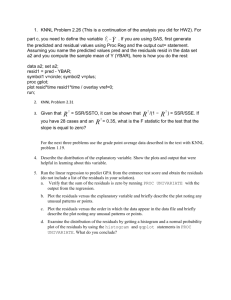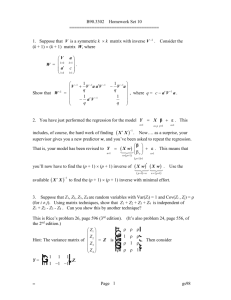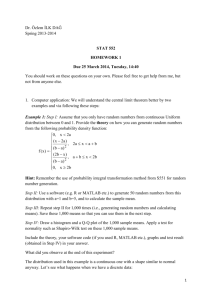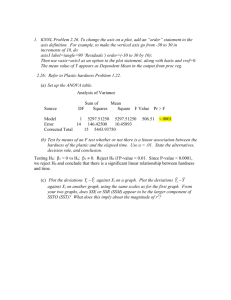An animal psychologist studied the pituitary function of hens put
advertisement
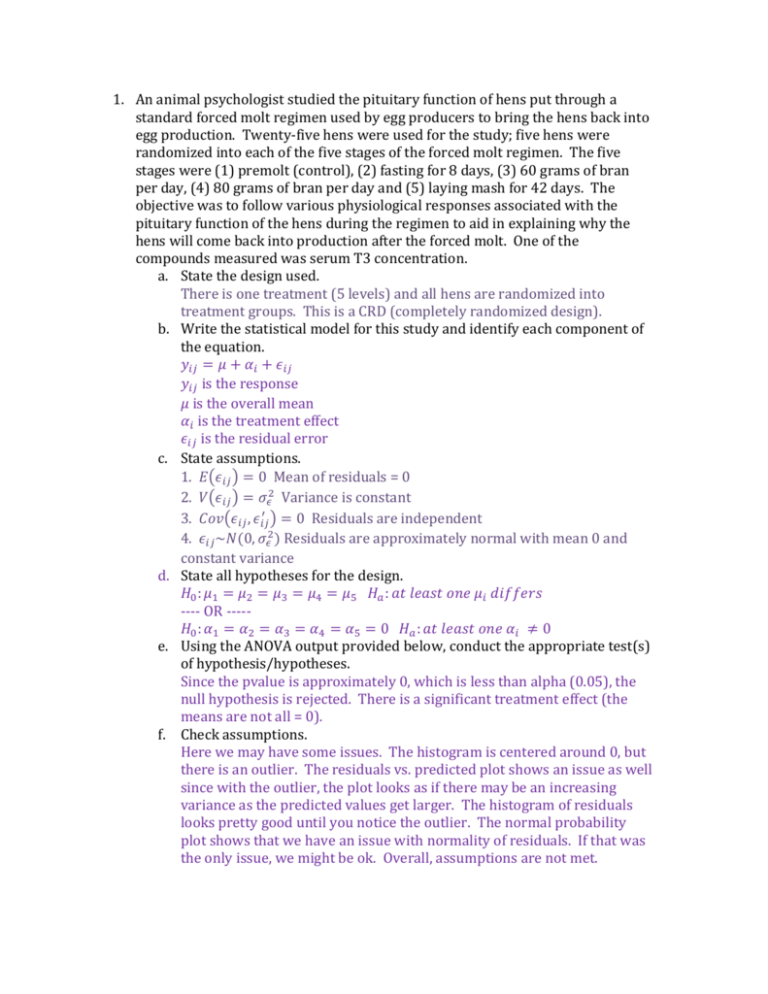
1. An animal psychologist studied the pituitary function of hens put through a standard forced molt regimen used by egg producers to bring the hens back into egg production. Twenty-five hens were used for the study; five hens were randomized into each of the five stages of the forced molt regimen. The five stages were (1) premolt (control), (2) fasting for 8 days, (3) 60 grams of bran per day, (4) 80 grams of bran per day and (5) laying mash for 42 days. The objective was to follow various physiological responses associated with the pituitary function of the hens during the regimen to aid in explaining why the hens will come back into production after the forced molt. One of the compounds measured was serum T3 concentration. a. State the design used. There is one treatment (5 levels) and all hens are randomized into treatment groups. This is a CRD (completely randomized design). b. Write the statistical model for this study and identify each component of the equation. 𝑦𝑖𝑗 = 𝜇 + 𝛼𝑖 + 𝜖𝑖𝑗 𝑦𝑖𝑗 is the response 𝜇 is the overall mean 𝛼𝑖 is the treatment effect 𝜖𝑖𝑗 is the residual error c. State assumptions. 1. 𝐸(𝜖𝑖𝑗 ) = 0 Mean of residuals = 0 2. 𝑉(𝜖𝑖𝑗 ) = 𝜎𝜖2 Variance is constant ′ 3. 𝐶𝑜𝑣(𝜖𝑖𝑗 , 𝜖𝑖𝑗 ) = 0 Residuals are independent 2 4. 𝜖𝑖𝑗 ~𝑁(0, 𝜎𝜖 ) Residuals are approximately normal with mean 0 and constant variance d. State all hypotheses for the design. 𝐻0 : 𝜇1 = 𝜇2 = 𝜇3 = 𝜇4 = 𝜇5 𝐻𝑎 : 𝑎𝑡 𝑙𝑒𝑎𝑠𝑡 𝑜𝑛𝑒 𝜇𝑖 𝑑𝑖𝑓𝑓𝑒𝑟𝑠 ---- OR ----𝐻0 : 𝛼1 = 𝛼2 = 𝛼3 = 𝛼4 = 𝛼5 = 0 𝐻𝑎 : 𝑎𝑡 𝑙𝑒𝑎𝑠𝑡 𝑜𝑛𝑒 𝛼𝑖 ≠ 0 e. Using the ANOVA output provided below, conduct the appropriate test(s) of hypothesis/hypotheses. Since the pvalue is approximately 0, which is less than alpha (0.05), the null hypothesis is rejected. There is a significant treatment effect (the means are not all = 0). f. Check assumptions. Here we may have some issues. The histogram is centered around 0, but there is an outlier. The residuals vs. predicted plot shows an issue as well since with the outlier, the plot looks as if there may be an increasing variance as the predicted values get larger. The histogram of residuals looks pretty good until you notice the outlier. The normal probability plot shows that we have an issue with normality of residuals. If that was the only issue, we might be ok. Overall, assumptions are not met. Normal Q-Q Plot 0 -4 -3 -2 -1 0 1 2 -4 -2 0 2 4 Residuals vs. Predicted 100 120 140 hens.pred -1 -2 -1 0 Theoretical Quantiles hens.resid hens.resid -2 -4 -3 2 4 Frequency 6 Sample Quantiles 0 8 1 10 Histogram of hens.resid 160 180 1 2 2. The self-inductance of coils with iron-oxide cores was measured under different temperature conditions of the measuring bridge. The coil temperature was held constant. Five coils were used for the experiment. The self-inductance of each coil was measured for each of the four temperatures (22°, 23°, 24° and 25°) for the measuring bridge. The temperatures were utilized in a random order for each coil. The measured response was percentage deviations from a standard. a. State the design used. Each coil is considered a block since each one was measured at each of the four temperatures. This is a Randomized Complete Block Design (RCBD). b. Write the statistical model for this study and identify each component of the equation. 𝑦𝑖𝑗 = 𝜇 + 𝛼𝑖 + 𝛽𝑗 + 𝜖𝑖𝑗 𝑦𝑖𝑗 is the response 𝜇 is the overall mean 𝛼𝑖 is the treatment effect 𝛽𝑗 is the block effect 𝜖𝑖𝑗 is the residual error c. State all hypotheses for the design. 𝐻0 : 𝛼1 = 𝛼2 = 𝛼3 = 𝛼4 = 0 𝐻𝑎 : 𝑎𝑡 𝑙𝑒𝑎𝑠𝑡 𝑜𝑛𝑒 𝛼𝑖 ≠ 0 d. Using the ANOVA output provided below, conduct the appropriate test(s) of hypothesis/hypotheses. Since we only need to check the F statistic for the treatment (here it’s the temperature), the pvalue is 0.005319 which is smaller than alpha (0.05) so the null hypothesis would be rejected. The treatment effect is significant. e. Check assumptions. The histogram of residuals is mostly centered around 0. The residuals vs. predicted plot shows no increasing or decreasing variance (so it’s constant). However, the normality assumption may have been violated. The histogram of residuals is symmetric but there are some outliers. The normal probability plot shows that there are four possible outliers (meaning that normality is not happening). Assumptions may be met, but the normality of residuals is not. Residuals vs. Predicted 0.00 coil.resid -0.02 0.00 -0.04 -0.04 -0.02 Sample Quantiles 0.02 0.02 0.04 0.04 Normal Q-Q Plot -2 -1 0 1 2 0 1 2 Frequency 3 4 5 Histogram of coil.resid -0.04 -0.02 0.00 coil.resid 0.2 0.4 0.6 0.8 coil.pred Theoretical Quantiles 0.02 0.04 1.0 1.2 1.4 3. A traffic engineer conducted a study to compare the total unused red light time for five different traffic light signal sequences. The experiment was conducted over five intersections and five time periods. a. State the design used. The intersection and the time period are both blocks with the light sequence being the treatment where every “row” and “column” have each level of the treatment. This is a Latin Squares Design. b. Write the statistical model for this study and identify each component of the equation. 𝑦𝑖𝑗𝑘 = 𝜇 + 𝛼𝑖 + 𝛽𝑗 + 𝛾𝑘 + 𝜖𝑖𝑗𝑘 𝑦𝑖𝑗𝑘 is the response 𝜇 is the overall mean 𝛼𝑖 is the treatment effect 𝛽𝑗 is the block 1 effect (rows) 𝛾𝑘 is the block 2 effect (columns) 𝜖𝑖𝑗𝑘 is the residual error c. State all hypotheses for the design. 𝐻0 : 𝛼1 = 𝛼2 = 𝛼3 = 𝛼4 = 𝛼5 𝐻𝑎 : 𝑎𝑡 𝑙𝑒𝑎𝑠𝑡 𝑜𝑛𝑒 𝛼𝑖 ≠ 0 d. Using the ANOVA output provided below, conduct the appropriate test(s) of hypothesis/hypotheses. The only test we do here is for the treatment since the other two are blocks. The pvalue for treatment is 0.04976, and is less than alpha (0.05). While it’s close, we will still reject the null hypothesis. The treatment effect (the timing sequence) is significant (marginally, but still significant). e. Check assumptions. The histogram of residuals is centered around 0. The residuals vs. predicted values plot looks random so the variance of the residuals is constant. The histogram of residuals is not quite symmetric, but is probably approximately normal enough to say that the residuals have a normal distribution (there’s no outliers so it should be ok). Residuals vs. Predicted 1 -1 -2 -3 -2 -3 -2 -1 0 1 15 2 0 2 4 6 8 Histogram of traffic.resid -3 -2 -1 0 1 traffic.resid 20 25 traffic.pred Theoretical Quantiles Frequency 0 traffic.resid 1 0 -1 Sample Quantiles 2 2 3 3 Normal Q-Q Plot 2 3 4 30 4. A chemical production process consists of a first reaction with an alcohol and a section reaction with a base. In this experiment, the alcohol has three levels and the base has two. The data collected were the percent yield. a. State the design used. Here we have two treatments, one with 3 levels and one with 2 levels. This is a 3X2 factorial design (completely randomized factorial design – CRF). b. Write the statistical model for this study and identify each component of the equation. 𝑦𝑖𝑗𝑘 = 𝜇 + 𝛼𝑖 + 𝛽𝑗 + 𝛾𝑘 + 𝜖𝑖𝑗𝑘 OR 𝑦𝑖𝑗𝑘 = 𝜇 + 𝛼𝑖 + 𝛽𝑗 + (𝛼𝛽)𝑖𝑗 + 𝜖𝑖𝑗𝑘 𝑦𝑖𝑗𝑘 is the response 𝜇 is the overall mean 𝛼𝑖 is the treatment A effect 𝛽𝑗 is the treatment B effect 𝛾𝑘 𝑜𝑟 (𝛼𝛽)𝑖𝑗 is the interaction between treatments A and B. 𝜖𝑖𝑗𝑘 is the residual error c. State all hypotheses for the design. Main effects: A 𝐻0 : 𝛼1 = 𝛼2 = 𝛼3 = 0 𝐻𝑎 : 𝑎𝑡 𝑙𝑒𝑎𝑠𝑡 𝑜𝑛𝑒 𝛼𝑖 ≠ 0 B 𝐻0 : 𝛽1 = 𝛽2 = 0 𝐻𝑎 : 𝑎𝑡 𝑙𝑒𝑎𝑠𝑡 𝑜𝑛𝑒 𝛽𝑗 ≠ 0 Interaction: (use either alpha-beta or gamma symbols) AB 𝐻0 : 𝛼1 𝛽1 = 𝛼2 𝛽2 = 𝛼3 𝛽3 = 𝛼4 𝛽4 = 𝛼5 𝛽5 = 𝛼6 𝛽6 = 0 𝐻𝑎 : 𝑎𝑡 𝑙𝑒𝑎𝑠𝑡 𝑜𝑛𝑒 𝛼𝛽𝑖𝑗 ≠ 0 d. Using the ANOVA output provided below, conduct the appropriate test(s) of hypothesis/hypotheses. Main effects: A: the pvalue is 0.29149, which is greater than alpha so we would not reject the null for treatment A effects being significant (A is not significant) B: the pvalue is 0.09103 which is greater than alpha so we would not reject the null for treatment B effects being significant (B is not significant) Interaction: AB: the pvalue is 0.01346 which is less than alpha so we reject the null hypothesis. That means the interaction between the treatments is significant. e. Check assumptions. The histogram of the residuals looks to be centered on 0. The residual vs. predicted plot looks to be random scatter so the variance is constant. The histogram of residuals looks a bit right skewed (and it showed on the normal probability plot) but the skew shouldn’t be too bad. So, the residuals are approximately normal. Residuals vs. Predicted -2 -1 0 1 2 0 1 2 3 4 5 6 7 Histogram of chem.resid -2 -1 0 1 chem.resid 89.0 89.5 90.0 90.5 chem.pred Theoretical Quantiles Frequency 0 chem.resid -1 0 -1 Sample Quantiles 1 1 2 2 Normal Q-Q Plot 2 3 91.0 91.5 92.0 5. A field plot experiment was conducted to evaluate the interaction between timing of nitrogen application to the soil (early, optimum, late) and two levels of a nitrification inhibitor (none, 0.5 lb/acre), all on three separate plots of the field. The inhibitor delays conversion of ammonium forms of nitrogen into a more mobile nitrate form to reduce leaching losses of fertilizer-derived nitrates. The nitrogen was supplied as pulse-labeled 15N through a drip irrigation system at an early, an optimum, and a late date of application. The data are the percent 15N taken up by sweet corn plants grown on the three plots. a. State the design used. We have three different plots that are to be used as blocks (since there could be variation in plants due to different soils in each plot), two different treatments (inhibitor and timing). This is a factorial treatment structure in a randomized block design (FDRB). b. Write the statistical model for this study and identify each component of the equation. 𝑦𝑖𝑗𝑘 = 𝜇 + 𝛼𝑖 + 𝛽𝑗 + 𝛾𝑘 + (𝛼𝛾)𝑖𝑘 + 𝜖𝑖𝑗𝑘 𝑦𝑖𝑗𝑘 is the response 𝜇 is the overall mean 𝛽𝑗 is the block effect 𝛼𝑖 is treatment A effect (timing) 𝛾𝑘 is treatment B effect (inhibitor) (𝛼𝛾)𝑖𝑘 is the interaction between treatments A and B. 𝜖𝑖𝑗𝑘 is the residual error c. State all hypotheses for the design. Main effects: A 𝐻0 : 𝛼1 = 𝛼2 = 𝛼3 = 0 𝐻𝑎 : 𝑎𝑡 𝑙𝑒𝑎𝑠𝑡 𝑜𝑛𝑒 𝛼𝑖 ≠ 0 B 𝐻0 : 𝛾1 = 𝛾2 = 0 𝐻𝑎 : 𝑎𝑡 𝑙𝑒𝑎𝑠𝑡 𝑜𝑛𝑒 𝛾𝑘 ≠ 0 Interaction: AB 𝐻0 : 𝛼1 𝛾1 = 𝛼2 𝛾2 = ⋯ = 𝛼12 𝛾12 = 0 𝐻𝑎 : 𝑎𝑡 𝑙𝑒𝑎𝑠𝑡 𝑜𝑛𝑒 𝛼𝛾𝑖𝑘 ≠ 0 d. Using the ANOVA output provided below, conduct the appropriate test(s) of hypothesis/hypotheses. Main effects: A: the pvalue is 0.005, which is less than alpha so we would reject the null for treatment A effects being significant (A is significant) B: the pvalue is 0.005 which is less than alpha so we would reject the null for treatment B effects being significant (B is significant) Interaction: AB: the pvalue is 0.08669 which is greater than alpha so we do not reject the null hypothesis. That means the interaction between the treatments is not significant. e. Check assumptions. The histogram of the residuals looks to be centered on 0. The residual vs. predicted plot looks to be random scatter so the variance is constant. The histogram of residuals looks a bit left skewed (and it showed on the normal probability plot) but the skew shouldn’t be too bad. So, the residuals are approximately normal. Normal Q-Q Plot -5 0 corn.resid 5 0 -5 -15 -10 -10 Sample Quantiles 10 5 15 Residuals vs. Predicted -2 -1 0 Theoretical Quantiles 1 2 20 30 40 corn.pred 50 60 3 2 1 0 Frequency 4 5 6 Histogram of corn.resid -15 -10 -5 0 corn.resid 5 10
